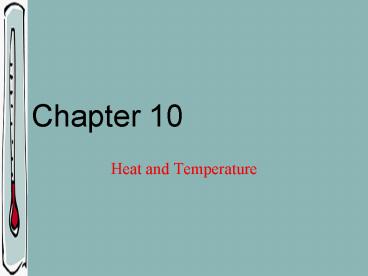Heat and Temperature - PowerPoint PPT Presentation
1 / 29
Title:
Heat and Temperature
Description:
Conduction: involves direct contact of objects with unequal temperatures. ... because of machines that transfer energy as heat from one place to another. ... – PowerPoint PPT presentation
Number of Views:50
Avg rating:3.0/5.0
Title: Heat and Temperature
1
Chapter 10
- Heat and Temperature
2
Temperature
- In science, not based on HOT or COLD.
- Based on kinetic energy of particles in object.
- KE increases ? temp increases
- KE decreases ? temp decreases
3
Thermometer
- Measure temp with thermometer.
- Different types for different tasks.
- Example
- In refrigerator ?Measures bending of metal
strips. - Digital ? Measures change in electricity.
4
Temp. Scales
- Fahrenheit scale
- Units F
- Freezing Point 32F
- Boiling Point 212F
- Celsius scale
- Units C
- Freezing Point 0C
- Boiling Point 100C
- Kelvin scale
- Units Kelvin (K)
- Freezing Point 273 K (absolute zero)
- Boiling Point 373 K
5
(No Transcript)
6
Conversions
- Celsius-Fahrenheit Conversion Equation
- Fahrenheit temp (9/5 x Celsius temp) 32
- F 9/5 C 32
- Fahrenheit-Celsius Conversion Equation
- Celsius temp 5/9 (Fahrenheit temp 32)
- C 5/9(F 32)
- Celsius-Kelvin Conversion Equation
- Kelvin temp Celsius temp 273
- K C 273
7
Conversion Example
- Convert 57.8C to degrees Fahrenheit and in
kelvins. - F 9/5 C 32
- F 9/5 (57.8) 32
- F 104 32 136 F
- K C 273
- K 57.8 273 331 K
8
Energy Transfer
- Sensation of temperature change is related to the
energy transfer taking place. - Holding ice cube in hand.
- Stepping into a hot bath.
- If neither feels warm or coldno energy transfer.
- Heat transfer of energy due to temperature
differences b/w two objects. - Greater difference in temp ? more energy transfer
9
Methods of Energy Transfer
- Conduction involves direct
contact of objects with unequal temperatures. - Convection results from the movement of warm
fluids itself (liquids gases). - Radiation doesnt require contact of objects
(electromagnetic waves) or movement of matter
(can happen in a vacuum)
10
(No Transcript)
11
(No Transcript)
12
(No Transcript)
13
(No Transcript)
14
Conductors
- Energy is transferred as heat quickly.
- Examples
- Metals Iron, copper, silver, etc
- Molten or liquid metals
15
Insulators
- Slow the transfer of energy as heat.
- Examples
- Liquids
- Wood
- Rubber or Plastics
- Gases (Air)
16
Specific Heat
- How much energy required to raise the temperature
a certain degree. - Determines if material good insulator or
conductor. - Smaller the specific heat ? better conductor
(absorbs heat/energy easiest) - Larger the specific heat ? better insulator
(absorbs the least energy)
17
(No Transcript)
18
Specific Heat Equation
- Energy (specific heat) x (mass) x (temp.
change) - H cm?T
- Specific heat units J/kgK or J/gC
- Water specific heat 4186 J/kgK
- 4.18 J/gC
19
Example
- How much energy must be transferred as heat to
the 420 kg of water in a bathtub in order to
raise the waters temperature from 25C to 37C? - H cm?T
- H 4186 J/kgK x 420 kg x 12 K
- H 21 000 000 J
20
Law of Conservation of Energy
- Heat lost Heat gained
- Remember H cm?T
- cm?T cm?T
- cm(T1-T2) cm(T2-T1)
- metal water
- Example to come in class.
21
Using Heat
- Heating and cooling of space is possible because
of machines that transfer energy as heat from one
place to another.
22
Heating Systems
- Work can be done to increase the temp.
- Examples
- Human body energy from food ? transferred as
heat to blood - Central heat circulate heated fluids to each
room - Solar heat used by reptiles and solar
collectors - Usable energy in all energy
transfers.
decreases
23
Insulation
- Used to minimize energy transfers.
- R-value rating to measure the effectiveness of
insulation materials. - Greater the R-value ? greater the ability to
decrease unwanted energy transfers.
24
(No Transcript)
25
Cooling Systems
- Energy still transferred, BUT leaves the first
substance with less energy and lower temp. - Examples
- Liquid refrigerants uses evaporation to change
into a gas (absorbs heat) and condenses back to a
liquid (releases heat) - Air conditioner uses process above convection
- Heat pumps can be used to cool or heat (reverse
process)
26
(No Transcript)
27
BACK
28
BACK
29
References
- Thermometer slide Pic http//puffernet.tripod.co
m - Temp Scales http//www.visionlearning.com/librar
y/modules/mid48/Image/VLObject-318-021121021101.gi
f - Energy Transfer Pic http//apollo.lsc.vsc.edu/cl
asses/met130/notes/chapter2/graphics/pan2.psd.gif
- Water Insulator Pic http//avstop.com/AC/apgener
al/imageAQ3.JPG - Snow Insulator Pic http//www.ukagriculture.com/
Field_to_Fridge/images/wheatimage_januarylarge3.jp
g - Specific Heat Chart http//images.encarta.msn.co
m/xrefmedia/aencmed/targets/illus/tab/T026242A.gif
- Molten Steel Pic http//www.nwpipe.com/images/pi
c_molten.jpg - Convection Pic http//www.stpaulmercantile.com/C
onvection.gif - R-values Pic physics.itsbaxter.com/thermal_insul
ation.html - Solar Heat Pic http//www.greenenergy.org.uk/sta
/images/SWHsystem.gif - Central Heat Pic http//www.diydata.com/planning
/central_heating/vented.gif - Air conditioner Pic http//home.howstuffworks.co
m/ac.htm - Refrigerator Pic http//www.energyquest.ca.gov/h
ow_it_works/images/refrigerator.gif - Anole Pic http//library.thinkquest.org/J0112365
/reptile/graphics/green_anole.jpg - Iguana Pic http//www.uvguide.co.uk/images/green
iguana.jpg































